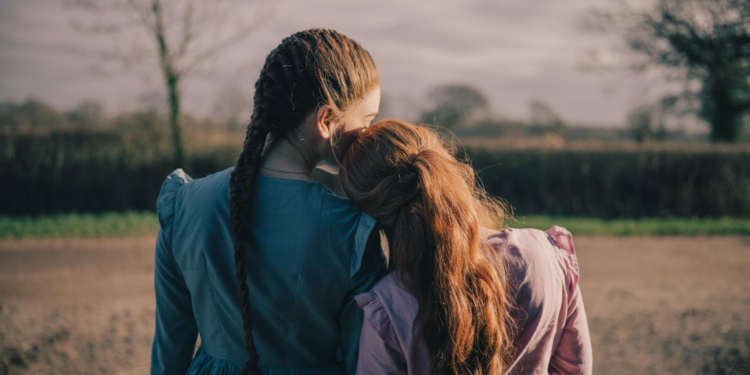When we think of images of some of this country’s strictest, most patriarchal religious communities, we think about the women who inhabit the world of Louisa Connolly-Burnham’s powerful short film Sister Wives. There is something so specific in the style of dress of the physicality of the people in these communities even if we haven’t had first-hand experience with them. Throughout her film, Connolly-Burnham captures the back of the heads of the two women who find themselves helpess to stop their attraction in a world that constantly tells them no or what to do. We can hear the heartbeats of these characters as they fall in love and feel their own emotions fluttering.
Kaidence has lived a devoted life with her husband, Jeremiah, since she was 14 years old, but they are struggling to conceive a child. ‘We are to become three,” he tells his wife one day when he arrives home. “She will join us tomorrow.” Jeremiah tells Kaidence that the other men in the community have accepted more than one wife into their home, so he can use that excuse to welcome 19 year-old Galilee as his second wife and Kaidence’s first sister wife. There is resistence, of course, but what can Kaidence do? Since Jeremiah is the man of the house, he makes all of the decisions.
When Jeremiah announces that he has to be away from home, we can see that Kaidence is curious as to what the dynamic will be with Galilee when they are alone, and her younget sister wife immediately surprises her with her personal questions and the revelation that she has a cell phone to keep in touch with her sister. Even though they are married to the same man and they share a life together, they ponder what life is like outside the community and think, “what if?” There is a sense of possibility without Jeremiah’s presence. They are allowed to think more freely, and god forbid, verbalize their thoughts and fears out loud. Connolly-Burnham establishes a real sense of paranoia even when the atmosphere is lighter. It all feels like it will come to an end when their husband comes home from his trip and Kaidence and Galilee are anxious to take advantage of his absence.
There is an inherent curiosity between these wives that transforms into trust and then attraction. These women are taught to keep so much of themselves down or hidden and to put men first that when Kaidence and Galilee have time to explore their emotions, it bursts through like a deluge. Their chins are held higher and their eyes are allowed to linger. Connolly-Burnham’s Kaidence feels like she remembers that young version of herself that she wishes she could apologize to, and I couldn’t help but stare at Kaidence’s eyes as she feels so much of herself bursting forth. When they are heavy with tears in a scene towards the end, we know she won’t let them fall without trying to make amends with herself.
Cinematographer Angela Zoe Neil captures some gorgeous use of color in a world determined to oppress. Kaidence and Galilee wear the same dresses for most of the film but against a bleak sky or a green field, they feel like they could serve as a lifeline to get to the next moment or the next day. The shots of the back of the women’s heads should be studied for how they provide the audience a reminder of what we think and feel about these communities, and the final series of shots are stunning.
Sister Wives displays a natural carnality threatening to explode. We want to be loved properly, to soothe our own yearing, and extend those feelings to others. There is freedom in exploring who you are, and Sister Wives is a damn fine declaration of the reasons we set ourselves loose.









